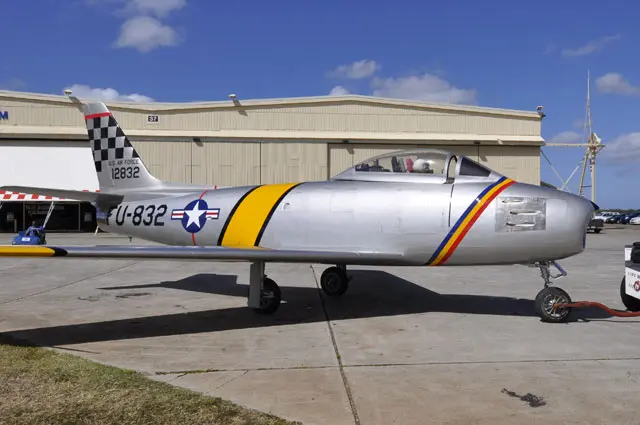Posted on April 02, 2013
By Ray Panko | [email protected] | Pearl Harbor Aviation Museum
Birth of the Sabre.
After World War II, countries built many aircraft designs to try to discover the best ways to use jet engines in fighters. All but one of the new designs by North American, with the exception of the F-86 Sabre, were originally proposed with straight wings. However, captured engineering data from postwar Germany showed the advantages of swept wings. As an aircraft approaches the speed of sound, the leading edges of some parts of the aircraft reach Mach 1 earlier than other parts. Affected sections emit shock waves perpendicular to the aircraft, sapping the aircraft’s speed and causing buffeting. (To people watching the aircraft fly by, these shock waves appear to form a cone around the aircraft.) Once an aircraft passes the sound barrier, this “Mach shock” bleeds off, but getting to that point proved to be difficult. By sweeping the wings back, designers could delay Mach shock on the wings, allowing the aircraft to fly closer to the speed of sound. After testing, the F-86 Sabre was redesigned to have 35-degree swept wings which added about a year to engineering development.

Figure 1: F-86 Sabre and MiG-15. Photo Courtesy Eric Van Gilder
MiGs and Sabres in Korea
During the Korean War, U.N. forces were stunned when large numbers of swept-wing fighters attacked from bases in Manchuria. Against fast, agile and high-flying MiG-15s, existing straight-winged Air Force jets such as the F-80 Shooting Star and the F-84 Thunderjet and Navy fighters such as the F9F Panther seemed a generation behind. The U.S. quickly dispatched a few squadrons of its new F-86A Sabre fighters and the two swept-wing fighters immediately began to mix it up in the border area between North Korea and Manchuria, a region known as “MiG Alley.”
The MiG and Sabre were evenly matched. The MiG could climb slightly faster and fly a bit higher, while the Sabre could outrun the MiG in a dive. At high altitudes, the smaller MiGs were more maneuverable. At lower altitudes, the situation was reversed. The Sabre had better visibility and was a more stable gun platform approaching Mach 1. Neither fighter had an after-burning engine, but the MiG-15’s KV-1 engine had 5,900 pounds of thrust in a lighter airframe, while the F-86A J-47 engine gave 5,200 pounds of thrust. Neither had great armament. The MiG-15 carried three hard-hitting but slow-firing cannons while the F-86 had six 50-calibre machine guns, better suited to shoot down World War II-era fighters.
Soon the U.S. introduced the F-86E, with a more powerful engine than the F-86A and an all-moving tail surface. Because the entire hydraulically actuated tail moved instead of just elevators, the E model had more bite on the airflow. This was critical at velocities near the speed of sound.
Later in the war, the U.S. introduced the F-86F model with 5,970 pounds of thrust and a newly designed wing without slats on the leading surfaces of the wing. Slats helped at low speeds during landings, but they reduced high-speed maneuverability. In addition, the wing root was extended six inches in the front and three inches in the rear. Although this seems like a small change, the fixed leading edge and the increased wing surface area considerably improved handling. The F-86F could finally turn tighter than the MiG-15bis, even at high altitudes.
Although the MiG-15bis and Sabre were very similar, the U.S. generally had more experienced pilots. In Korea, Sabre pilots claimed 808 MiG-15 kills against a loss of only 58 F-86s. This was a claimed kill ratio of almost 14:1. So it is not surprising that 40 of 41 Korean War aces flew the Sabre. Among them was Capt. Joseph McConnell, whose 16 kills is still the highest number of U.S. kills in a jet fighter. When Soviet archives were opened after the end of the Cold War, it was found that the claimed number of kills was high, but even the Soviets admitted to the loss of at least 345 Soviet MiG-15s, with Chinese and North Vietnamese also suffering many MiG losses.
Despite the Sabre’s success, the Air Force was reluctant to commit scarce F-86s to Korea. Even in the summer of 1951, there were only 44 F-86s to face 445 MiGs. Even with additional Sabre deliveries, there were only 127 Sabres in Korea in February 1952, and many were inoperable. This disparity in numbers continued throughout the war, negating many of the benefits of the Sabre’s kill ratio.
After the Korean War, the Sabre had a long service life. During the 1960s, it was Air Force’s mainstream fighter. The Navy also adopted a navalized version of the Sabre, the FJ-Fury. After the Air Force replaced F-86s with newer aircraft, Sabres were given to Air National Guard units to defend American air space. Several other Western countries used the Sabre and Canada produced some. In all, 9,800 Sabres/Furies were built in the United States and Canada. This made the Sabre the West’s most widely built jet fighter.
The Prototype and Controversy
The XP-86 prototype first flew on October 1, 1947. The pilot was North American Aviation’s chief test pilot, George S. Welch. If that name sounds familiar, Welch took to the air on December 7, 1941 and shot down four Japanese aircraft during the attack on Pearl Harbor. The story of his two sorties with 2nd Lt. Ken Taylor during the attack was the basis for action in the movie Pearl Harbor.


Figures 2 & 3: XP-86 Sabre NMAF 060829-F-1234S-013 & George S. Welch
On his first and second flights in the XP-86, Welch claimed that he took the prototype supersonic in a dive. North American’s aerodynamicist also argued that Welch may have gone supersonic in another flight, Both flights took place before then-Captain Chuck Yeager broke the sound barrier in the Bell X-1A. Of course, records must be made in level flight, and there is no question that Yeager was the first person to do this. In addition, the prototype proved in 1948 that it was perfectly capable of going supersonic in a dive. Welch’s dives were also not instrumented. It is clear that the flight test program progressed very slowly in ramping up speed.
If North American knew that the aircraft had already gone supersonic, why would it have waited until 1948 to build a supersonic dive into the test program? We will probably never know the true story. Later, Welch was the chief test pilot on the XF-100. On the first test flight, he went supersonic in the Super Sabre. Unfortunately, Welch died in the prototype on a later flight when the aircraft disintegrated.
Our F-86 Sabre (51-2832)
Our Sabre (Serial Number 51-2832) was manufactured in Inglewood, California on March 24, 1952. It was sent to Japan and then to the 51st Fighter-Interceptor Wing at the Suwon and Kisarazu Air Force bases in Korea. After the war, the fighter was stationed in several bases in Japan. In June 1956, it moved to the 199th Fighter-Interceptor Squadron at Hickam AFB, Hawaii where it guarded Hawaii’s skies until May 1958.
The 51st FIW was known as the ‘checkerboards’ because of the black-on-aluminum checkerboard pattern on their vertical stabilizers. The Wing’s first commander after it transitioned to F-86s was Col. Francis “Gabby” Gabreski, who was America’s top European Ace in World War II (and also present in Hawaii during the Pearl Harbor attack). He got another 6.5 kills in Korea. During the war, the checkerboards claimed 312 MiGs. Fourteen checkerboard pilots became aces, including Joseph C. McConnell. Two future astronauts flew for the 51st. John Glenn, on loan from the Marines, had three kills in only 11 days while Buzz Aldrin had two.


Figures 4 & 5: Captain McConnell, NMAF Photo & John Glenn, NMAF 050311-F-1234P-040
In 2010, on the anniversary of the beginning of the Korean War, Pearl Harbor Aviation Museum unveiled a “MiG Alley” air base exhibit with a MiG and Sabre in combat. As was typical, the MiG has the initial height advantage. Our Sabre is marked as Nina II, serial number 51-2841, to honor the F-86E that was flown by Col. John Mitchell, commander of the 51st Fighter Interceptor Group, Suwon Air Force Base, Korea.


Figure 6: The Nina II on Display

Figure 7: Pearl Harbor Aviation Museum’s F-86E after restoration



